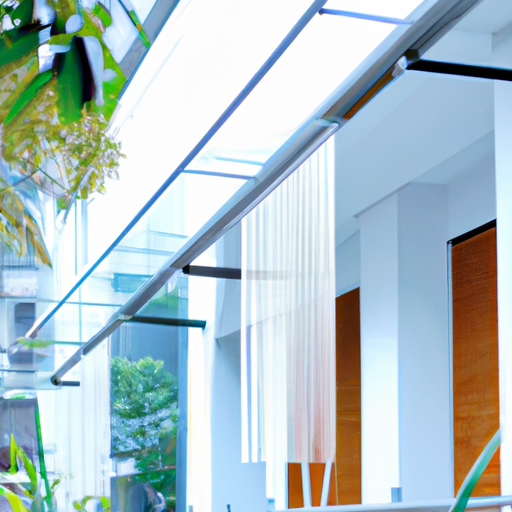Innovative Materials and Techniques for Eco-Friendly Construction
Sustainable architecture is an innovative approach to design and construction that seeks to minimize the negative environmental impact of buildings. This is achieved by enhancing efficiency and moderation in the use of materials, energy, and development space. As the world grapples with the effects of climate change and resource depletion, sustainable architecture has become increasingly important in the quest for a more eco-friendly built environment. This article will explore some of the innovative materials and techniques that are being employed in sustainable construction to create buildings that are not only aesthetically pleasing but also environmentally responsible.
One of the most significant aspects of sustainable architecture is the use of eco-friendly building materials. These materials are typically sourced from renewable resources, have low embodied energy, and are recyclable or biodegradable. Some examples of sustainable building materials include reclaimed wood, recycled metal, and natural materials such as straw, bamboo, and rammed earth. By using these materials, architects and builders can reduce the environmental impact of their projects while also conserving valuable resources.
In addition to using sustainable materials, innovative construction techniques can also contribute to the overall eco-friendliness of a building. One such technique is modular construction, which involves the off-site fabrication of building components that are then transported to the construction site for assembly. This method not only reduces waste and material consumption but also minimizes the disruption to the local environment caused by traditional construction methods. Another technique that is gaining popularity is green or living roofs, which involve the installation of vegetation on the roof of a building. Green roofs provide numerous environmental benefits, including improved air quality, reduced stormwater runoff, and increased energy efficiency.
Energy efficiency is another crucial aspect of sustainable architecture. By incorporating energy-efficient technologies and design strategies, architects can create buildings that consume less energy and produce fewer greenhouse gas emissions. Some examples of energy-efficient technologies include solar panels, wind turbines, and geothermal heating and cooling systems. These renewable energy sources can be integrated into the design of a building to generate electricity, heat, or cooling, thereby reducing the building’s reliance on fossil fuels and lowering its carbon footprint.
In addition to energy efficiency, water conservation is another essential component of sustainable architecture. Innovative techniques for water management can help to reduce a building’s water consumption and minimize its impact on local water resources. One such technique is rainwater harvesting, which involves the collection and storage of rainwater for use in irrigation, toilet flushing, and other non-potable applications. Greywater recycling systems can also be incorporated into a building’s design to reuse water from sinks, showers, and washing machines for irrigation or toilet flushing, thereby reducing the demand for fresh water.
Lastly, sustainable architecture also considers the impact of a building on its surrounding environment and the well-being of its occupants. This can be achieved through the careful selection of a building’s site, orientation, and landscaping, as well as the incorporation of natural ventilation and daylighting strategies. By creating buildings that are in harmony with their surroundings and provide a healthy and comfortable environment for their occupants, architects can contribute to the overall sustainability of the built environment.
In conclusion, sustainable architecture is an essential approach to design and construction that seeks to minimize the negative environmental impact of buildings. By employing innovative materials and techniques, architects and builders can create structures that are not only aesthetically pleasing but also environmentally responsible. As the world continues to face the challenges of climate change and resource depletion, sustainable architecture will play an increasingly important role in the quest for a more eco-friendly built environment.
Integrating Renewable Energy Sources into Modern Architectural Design

Sustainable architecture is an innovative approach to building design that focuses on minimizing the negative environmental impact of structures by enhancing efficiency and moderation in the use of materials, energy, and development space. As the world grapples with the effects of climate change and the depletion of natural resources, the need for sustainable solutions in various sectors, including architecture, has become increasingly apparent. One of the most effective ways to achieve this is by integrating renewable energy sources into modern architectural design.
Renewable energy sources, such as solar, wind, and geothermal power, offer a clean and sustainable alternative to traditional fossil fuels. By incorporating these energy sources into architectural design, architects can create buildings that not only reduce their carbon footprint but also contribute to the global effort to combat climate change. This integration of renewable energy sources into modern architectural design is not only beneficial for the environment but also for the building’s occupants, as it can lead to significant cost savings in terms of energy consumption.
One of the most popular renewable energy sources in sustainable architecture is solar power. Solar panels can be seamlessly integrated into the design of a building, either as rooftop installations or as part of the building’s facade. This allows the structure to generate its own electricity, reducing its reliance on the grid and lowering energy costs. In addition to solar panels, solar water heating systems can also be incorporated into the design, providing a sustainable solution for heating water for domestic use.
Wind power is another renewable energy source that can be integrated into architectural design. Small-scale wind turbines can be installed on rooftops or within the building’s structure, harnessing the power of the wind to generate electricity. This can be particularly effective in areas with consistent wind patterns, such as coastal regions or high-altitude locations. Moreover, the use of wind turbines in architectural design can also serve as a visual statement, showcasing the building’s commitment to sustainability and environmental responsibility.
Geothermal energy is a lesser-known but equally effective renewable energy source that can be incorporated into sustainable architecture. By tapping into the Earth’s natural heat, geothermal systems can provide heating and cooling for a building, significantly reducing its energy consumption. This can be achieved through the use of ground-source heat pumps, which transfer heat between the building and the ground, or through the use of geothermal wells, which harness the Earth’s heat directly. While the initial investment for geothermal systems can be high, the long-term savings in energy costs make it a worthwhile consideration for sustainable architectural design.
In addition to integrating renewable energy sources, sustainable architecture also focuses on other aspects of environmental design, such as passive heating and cooling, natural ventilation, and the use of sustainable materials. By combining these elements with renewable energy sources, architects can create buildings that are not only environmentally friendly but also comfortable and aesthetically pleasing.
As the world continues to face the challenges of climate change and resource depletion, the importance of sustainable architecture cannot be overstated. By integrating renewable energy sources into modern architectural design, architects can play a crucial role in reducing the environmental impact of the built environment and contribute to the global effort to create a more sustainable future. With advancements in technology and a growing awareness of the need for sustainable solutions, the integration of renewable energy sources into architectural design is set to become an increasingly prominent feature of the buildings of tomorrow.
Green Roofs and Living Walls: Transforming Urban Spaces
Sustainable architecture is an innovative approach to design and construction that seeks to minimize the negative environmental impact of buildings. This is achieved by enhancing efficiency and moderation in the use of materials, energy, and development space. One of the most promising trends in sustainable architecture is the incorporation of green roofs and living walls into urban spaces. These features not only improve the aesthetic appeal of buildings but also provide numerous environmental and economic benefits.
Green roofs, also known as vegetated or eco-roofs, are essentially rooftop gardens that consist of a waterproofing membrane, a root barrier, a drainage system, and a growing medium for plants. They can be installed on a wide range of buildings, from residential homes to large commercial structures. Living walls, on the other hand, are vertical gardens that can be attached to both the interior and exterior walls of a building. They are composed of pre-vegetated panels or fabric systems that support a diverse array of plant species.
One of the primary benefits of green roofs and living walls is their ability to reduce the urban heat island effect. This phenomenon occurs when the temperature in densely populated areas is significantly higher than in surrounding rural areas, due to the prevalence of heat-absorbing surfaces such as concrete and asphalt. Green roofs and living walls help to mitigate this effect by providing shade and releasing moisture through a process called evapotranspiration. This not only helps to cool the surrounding air but also reduces the demand for air conditioning, thereby lowering energy consumption and associated greenhouse gas emissions.
Another advantage of incorporating green roofs and living walls into urban spaces is their capacity to improve air quality. Plants naturally filter pollutants and particulate matter from the air, which can be particularly beneficial in cities with high levels of air pollution. Moreover, the vegetation on green roofs and living walls can absorb and store carbon dioxide, a major contributor to climate change. This process, known as carbon sequestration, helps to offset the carbon emissions generated by the building itself and other human activities.
In addition to their environmental benefits, green roofs and living walls can also contribute to the economic sustainability of a building. For instance, they can extend the lifespan of a roof by protecting it from ultraviolet radiation, temperature fluctuations, and physical damage. This can result in significant cost savings over time, as the need for roof repairs and replacements is reduced. Furthermore, green roofs and living walls can increase a building’s property value, as they are often perceived as attractive and desirable features by potential buyers or tenants.
Green roofs and living walls also offer social benefits, particularly in urban environments where access to green space may be limited. They can provide a calming and restorative effect on building occupants, helping to reduce stress and improve overall well-being. Additionally, green roofs and living walls can contribute to urban biodiversity by providing habitat for a variety of plant and animal species, including pollinators such as bees and butterflies.
In conclusion, the integration of green roofs and living walls into sustainable architecture is a transformative approach that can significantly enhance the environmental, economic, and social performance of buildings. By embracing these innovative design features, architects, developers, and building owners can not only create visually appealing structures but also contribute to the creation of healthier, more resilient, and more sustainable urban spaces. As the world continues to grapple with the challenges of climate change and rapid urbanization, green roofs and living walls offer a promising solution for building with the environment in mind.
Q&A
Question 1: What are the key principles of sustainable architecture?
Answer 1: The key principles of sustainable architecture include energy efficiency, use of renewable resources, waste reduction, water conservation, and creating healthy indoor environments.
Question 2: How do green roofs contribute to sustainable architecture?
Answer 2: Green roofs contribute to sustainable architecture by providing insulation, reducing heat island effect, managing stormwater runoff, and creating habitats for local flora and fauna.
Question 3: What are some common materials used in sustainable architecture?
Answer 3: Common materials used in sustainable architecture include recycled or reclaimed materials, locally sourced materials, renewable resources like bamboo and cork, and low-impact materials such as rammed earth and straw bale.
Conclusion
In conclusion, sustainable architecture is an essential approach in contemporary building design that prioritizes the environment by incorporating energy efficiency, resource conservation, and ecological balance. By integrating innovative technologies, materials, and design strategies, sustainable architecture not only reduces the negative environmental impact of buildings but also enhances the well-being of occupants and promotes long-term economic benefits. As global environmental concerns continue to rise, adopting sustainable architecture practices is crucial in creating a more resilient and environmentally responsible built environment for future generations.


